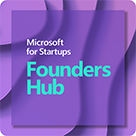AI has become more accessible to startup founders than ever before. This month, we’re partnering with #30DaysOfAzureAI to share the best AI resources, stories, and opportunities for startups.
In the past few months, generative AI has become a valuable partner for startups that want to quickly leverage the power of AI in their domains. Generative AI offers a range of products and services that enable startups to leverage capabilities like natural language processing, computer vision, and generative design.
In this blog post we explore three common startup use cases that leverage Azure OpenAI Service, the leading generative AI models for startups. Azure OpenAI Service is available as a benefit of the Microsoft for Startups Founders Hub program, both directly with OpenAI credits as well as access to Azure OpenAI APIs. Embracing these use cases can help startups improve their customer service, content creation, marketing, data analysis, product features, security, quality control, user experience, product development, prototyping, testing, and optimization. While there are many avenues startups can explore with Azure OpenAI Service, there are a few leading use cases that are a great starting point for piloting this technology in existing SaaS offerings and learning the best ways to infuse it into existing applications.
Use case 1: Natural language processing (NLP)
Perhaps the most common use case across many members of the Founders Hub program is natural language processing (NLP), a branch of AI that deals with understanding and generating natural language, such as text and speech. NLP can help startups improve their customer service, content creation, marketing, and data analysis. For example, Azure OpenAI Service’s GPT-4 is a deep learning system that can generate coherent and relevant text based on a given prompt. Startups can use GPT-4 to create chatbots, product descriptions, email campaigns, and summaries, and it can also answer questions, perform calculations, and provide recommendations based on natural language queries.
Use case 2: Hyper-personalization
Another interesting use case is leveraging OpenAI for hyper-personalization of applications to drive better user engagement. This branch of AI is often called generative design as it is used to create novel, optimal designs based on user profiles, criteria, and constraints. Generative design can help startups innovate in product development, prototyping, testing, and optimization. For example, Azure OpenAI Service’s DALL-E is a deep learning system that can generate realistic and diverse images based on natural language inputs and data classifications which could be different at the user level. With this approach, startups can use DALL-E to build personalized designs based on natural language commands and collected user data. This could be used for generating logos, icons, illustrations, mockups, and product pages while also manipulating existing images to reflect personalization needs and real-time user signals.
Use case 3: Unstructured data
But perhaps the most interesting use case for this technology that is quickly becoming a best practice for startups across many industries and verticals is the ability to reason over vast amounts of unstructured data. Such data was previously almost inaccessible to most startups due to the high level of complexity and lack of dedicated data scientist resources (especially for startups in an early-stage phase). Reasoning over data is the ability to extract insights, patterns, and knowledge from large and complex datasets, using natural language or code. This can help startups solve problems, make decisions, and create value from data. For example, a startup that wants to analyze customer feedback can use Azure OpenAI Service’s GPT-4 model to generate summaries, sentiment analysis, and recommendations based on the feedback. It can also use GPT-4 models alongside Azure OpenAI Service capabilities like speech-to-text and Form Recognizer to find specific data points across various types of unstructured data and move them to a structured format. That structured data can then be easily analyzed for insights with tools like Power BI.
Use case 3 drilldown: Converting unstructured data to a structured format
Using the Azure OpenAI Service GPT-4 model to convert unstructured data to structured data involves just a few simple steps:
- Define your input and output format. Specify what kind of unstructured data you want to convert and what kind of structured data you want to get. For example, you may want to convert a text document into a table or a spreadsheet.
- Provide some examples. Provide examples of how the input and output should look. For example, you may provide a sample text document and a corresponding table or spreadsheet that shows how the data should be extracted and organized. The more examples you provide, the better the model can learn from them and generalize to new inputs.
- Fine-tune the model. Fine-tune the OpenAI GPT-4 model on your examples using a suitable learning algorithm and hyperparameters. This allows the model to adapt to your specific task and domain and improve its performance.
- Generate the output. Feed your unstructured data to the fine-tuned OpenAI GPT-4 model and let it generate structured data in your desired format. You may need to post-process the output to ensure its quality and accuracy.
As an example, let’s use the following prompt based on a hypothetical call center interaction that was converted to text with the Text-to-Speech API in Azure:
Convert the call transcript into JSON format with fields for first name, last name and reason for calling.
Example:
Input:
Hello, this is Alice from XYZ company. How may I assist you?
Hi Alice, this is Bob Jones. I been following up on your startup for a while and using the free version you just shared. I’ve recently reached the threshold for using this app for free so I’m reaching out to create a paid subscription
Output:
{
“first_name”: “Bob”,
“last_name”: “Jones”,
“reason_for_calling”: “create a paid subscription”
}
Generative AI is already creating value for startups
The use cases shared above are emerging as generative AI best practices among our Microsoft for Startups Founders Hub members. While there are many areas to explore with this technology, leveraging natural language understanding and generation capabilities to infer the structure and meaning of unstructured data is a common starting point for startups, as it spans a variety of applications and solutions. For early-stage companies with an early adopter’s mindset, leveraging generative AI models across an application can quickly infuse innovation, create a competitive edge, and unlock new engagement models.
If you haven’t joined the Microsoft for Startups program, sign up for Founders Hub today. You’ll get immediate access to Azure OpenAI Service so you can start experimenting with this technology. You will likely be surprised by the comprehensiveness of the models, their capabilities, and their ease of use across many areas of your startup.











